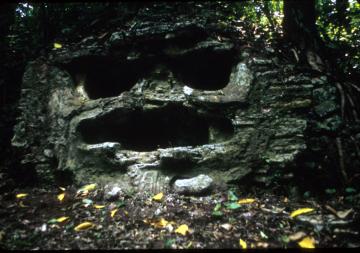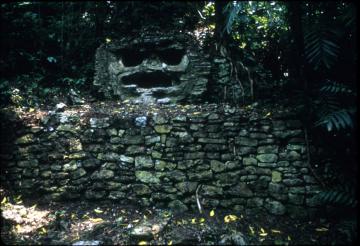| |
The Piedras Negras Project, 1997 Season
Vea este informe en Español.

Research Year: 1997
Culture: Maya
Chronology: Classic
Location: Guatemala
Site: Piedras Negras
Piedras Negras is a large Classic Maya city located on the Guatemalan bank of the Usumacinta River. Nearly a decade of intensive exploration by the University Museum, University of Pennsylvania, along with a smattering of visits by earlier explorers, achieved almost paradoxical results: a good-to-excellent record of monumental sculpture and the lay-out of some temple summits, but little-to-no understanding of more modest constructions, regional settlement, or a sophisticated comprehension of ceramics and other artifacts at the site. For the 1997 field season, we had a number of objectives in mind. These are listed below, along with comments on results from the season.

- Solution of logistical difficulties in working at site: We constructed and provisioned a camp of 30+ staff and laborers.
- Extensive test-pitting to determine and revise chronology at Piedras Negras: Test pits were excavated, resulting in probes over most of the site.
- Recovery of a larger collection of artifacts, and with adequate provenience: The project recovered over 30,000 sherds, along with other objects. These established a chronology ranging from the Middle Preclassic through Terminal Classic periods, including material from the Protoclassic.
- Excavations in monumental architecture, including southern sector (presumed to be Early Classic in date) and northern sector (presumed to come from the Late Classic period): Excavations in Pyramid J-4, Court 3 of the Acropolis (the presumed palace of Piedras Negras), S-11 (containing a round building of Early Classic date), and near R-5 (buried structures 5 m. in height, all from the Early Classic period) revealed the potential at Piedras Negras for future excavations in monumental architecture. The University Museum investigations significantly altered some temple summits, particularly that of Pyramid O-13. Nonetheless, we discovered that, with a few exceptions (Pyramid K-5 and Court 1 of the Acropolis), they did not penetrate deeply into the core of larger buildings at the site.
- Linkage of deciphered monumental texts with locations of probable tombs; establishment of correlations between rulers and archaeological remains: Deep pits on the front axis of Pyramid O-13 exposed a burial, with glyphic texts and over 100 pieces of jade, that may belong to Ruler 4 of Piedras Negras. The much-burned remains conceivably relate to tomb burning references on Panel 3.
- Evaluation of buildings for possible consolidation in the future; photography and registry of sculpture still at the site: In 1998 we hope to consolidate the P-7 sweatbath and portions of the Acropolis, all of which were buttressed with wooden supports in 1997. Despite looting, a majority of stelae remain at the site, some in relatively good state of preservation. Better-preserved fragments were buried in marked locations.
- Stabilization of structures and trenches left exposed by the University Museum: A project of a different era, the University Museum expedition did not backfill any of its operations. In some buildings, such as Pyramid O-13, it ejected several tons of rubble from summit excavations onto stelae and altars in the plaza below. We have begun to remove such rubble and to backfill operations, work that will continue for the duration of the project.
- Extension of Pennsylvania map into unsurveyed sectors of Piedras Negras: The project mapped to the south of Piedras Negras, finding many more monumental terraces, some of which were trenched. Fill depth in this sector reached over 5 meters.
- Commencement of regional survey and excavations in areas well beyond the Pennsylvania map: Profs. David Webster and Perry Hardin explored, surveyed, and excavated in areas well to the north of the Penn map, extending as far as El Porvenir, a subsidiary site with Preclassic to Late Classic occupation in a river valley that empties into the Usumacinta River.
- Establishing and testing a soil testing lab on-site: Prof. Perry Hardin of BYU successfully implemented a soil-testing lab at the ruins, resulting in immediate feedback to excavators about phosphate concentrations and possible midden loci in habitational sectors.
Click to download the report in PDF format:
The Piedras Negras Project, 1997 Season (134 KB)
The PDF files require Adobe Acrobat Reader.
To download the latest version, click the Get Acrobat Reader button below.

Submitted 05/01/1997 by:
For additional information on research at Piedras Negras:
Index of Piedras Negras Projects
Search the Piedras Negras Archive
|



